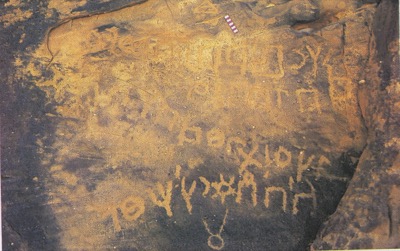Sigla: Esk. 272; Kootstra 2016: 100 Script: Taymanitic
Transliteration
1: nʿml/b lbd
2: hrg/ddn{/}ʾl wnʿ
3: ṯġf h- kdwrt/{f} hl
4: k/{ʾ}ṯr -h/ḥwl
Translation
1: Nʿml son of Lbd,
2: destroyer of Dedan, of the lineage of Wnʿ
3: he slaughtered and bled the Kdwrt {and then}
4: he went in its {footsteps} [i.e. he pursued it] for a year [or: with great force]
Apparatus Criticus
TEXT
Line 1. Eskoubi (line 2): nʿml b ldb as line two, after ʾl wnʿ.
Line 3. Eskoubi: ḍġbh bdwlt fhl rather than ṯġf h- kdwrt; Kootstra: s³ġ {b} rather than ṯġf.
Line 4. Eskoubi: k bṣs²r -h for k {ʾ}ṯr -h; Kootstra: b{ʾ}ṯr -h for {ʾ}ṯr -h.
TRANSLATION
Line 1. ʾl wnʿ, Eskoubi: personal name.
Line 2. hrg, Eskoubi: personal name.
Line 4. ḥwl, Eskoubi: adverb of time.
Commentary
See Macdonald, in press g, Appendix 1.
The name nʿml has been found once before in Taymanitic (JSTham 450). Lbd is known from Dadanitic and Safaitic. This is the first occurrence of the lineage name wnʿ.
We have interpreted the title hrg ddn as *hārig dadan “Destroyer of Ddn”, on the basis of the root H-R-G in Arabic and North-West Semitic, one of whose basic meanings is “to slaughter” (see, for instance, Arabic harj “confusion, disorder, slaughter”), Hebrew hārag "to kill, slaughter".
The third line is the most difficult to interpret. Tentatively, we would relate ṯġb to Arabic ṯaġaba “to slaughter and bleed (an animal)” taking it as a contemptuous metaphor for killing someone. The next six letters presumably give the name or title of the person he killed. The h could be the definite article but it is difficult to interpret what follows. The w cannot represent a vowel in the Taymanitic orthography and so h-kdwrt would make a curious name. The third person singular enclitic pronoun, –h, after ʾṯr in the next line must refer back to h-kdwrt and so precludes reading it as two names, hkd w rt. Although it is much longer than the others, the vertical line following the t can only be a word-divider, since no letter in the Taymanitic alphabet has this form.
We have taken the following letter as a f, though it could equally be a ʿ, these two letters having very similar shapes in Taymanitic. The basic meaning of the root H-L-K in the Semitic languages is “to go”. It is interesting that the preposition b is separated from the following word by a word-divider. The next word ʾṯr-h “his traces, footsteps” is clear. Although the “horns” of the ʾ have been joined to form a circle, the letter can only be a ʾ since this is not a form which ṣ takes in Taymanitic. The final word is ḥwl which we would suggest represents something equivalent to Arabic ḥawlan “for a year”, or “with great force”. For another text ending in ḥwl see Esk 020.
Subjects
Genealogy
Place-name
Lineage
Time
Country: Saudi Arabia
Region: Tabūk
Site: Al-Buwayb al-Ṣanāʿī, near to Taymāʾ
Map reference: Eskoubi: 27 23 34.5 N 38 25 52.0 E
Latitude: 27.23345
Longitude: 38.25520
Present Location: In situ
Associated Signs: (1). an Ancient South Arabian z above the text. (2). a ṣ (circle with straight horns below ʾṯr-h in line 4
References:
[Esk] Eskūbī [Eskoubi] Ḫ.M. Dirāsah taḥlīliyyah muqāranah li-nuqūš min minṭaqah (rum) ǧanūb ġarb taymāʾ. [English title: An Analytical and Comparative Study of Inscriptions from “Rum” region, South West of Tayma. Riyāḍ: wazīrat al-maʿārif, waqālat al-āṯār wa-l-matāḥif, 1999. Pages: 359–362
Kootstra, F. The Language of the Taymanitic Inscriptions and its Classification. Arabian Epigraphic Notes 2, 2016: 67–140 Pages: 100
Macdonald, M.C.A. Catalogue of the Inscriptions discovered in the Saudi-German excavations at Taymāʾ 2004–2015. With contributions by A. Hausleiter, F. Imbert, H. Schaudig, P. Stein, F. Tourtet, and M. Trognitz . Oxford: Archaeopress, 2020.
URL of this record (for citation): http://krc.orient.ox.ac.uk/ociana/corpus/pages/OCIANA_0040126.html

